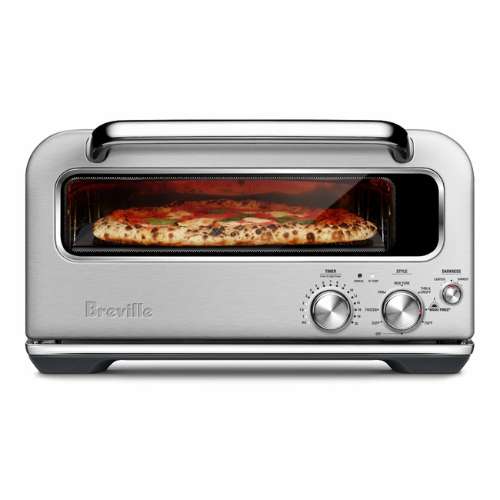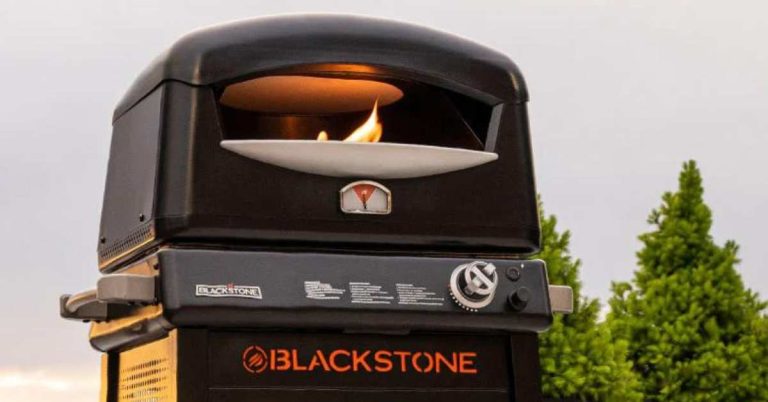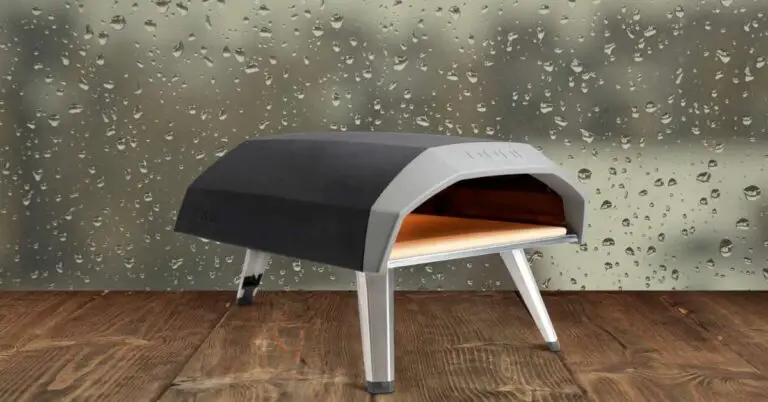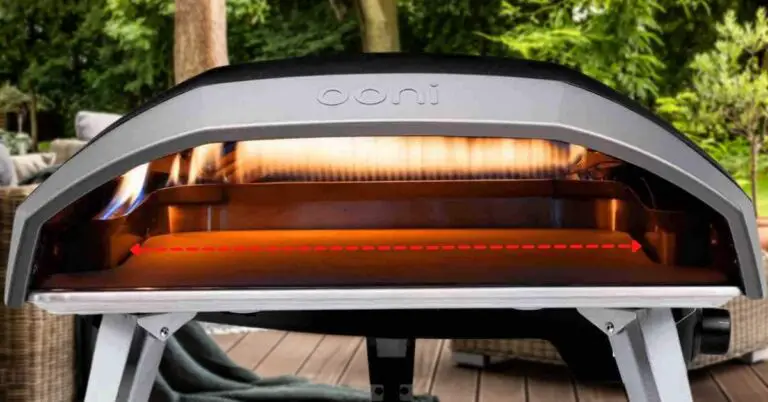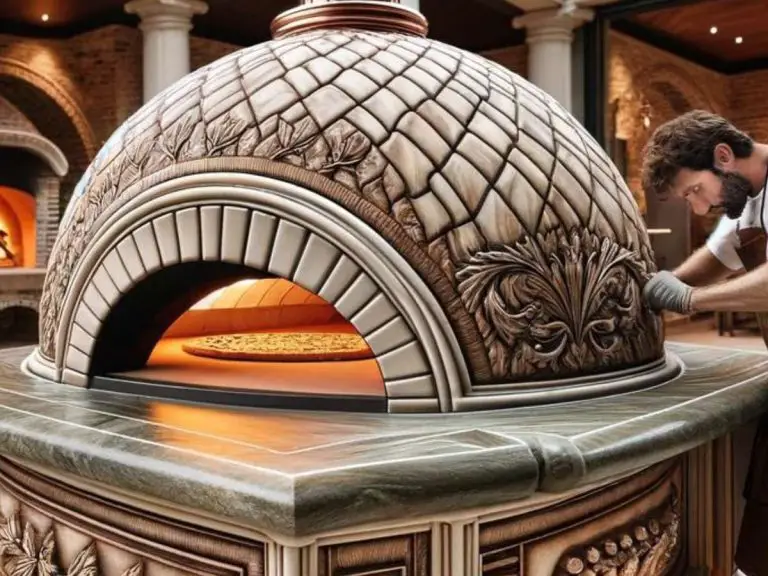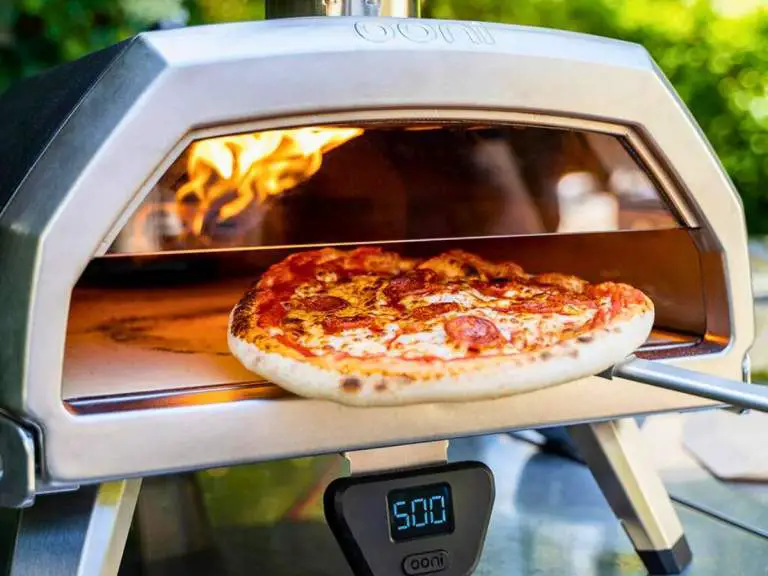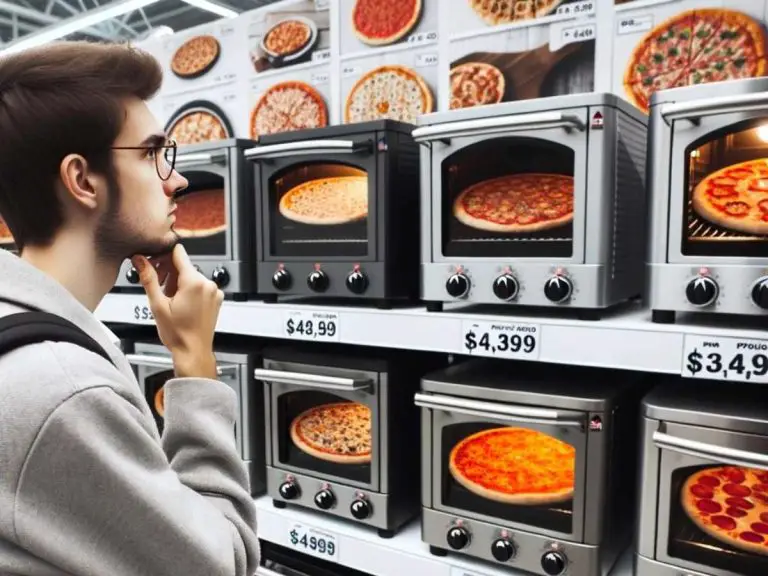Best Indoor Pizza Ovens: 4 Electric Pizza Ovens You Can Actually Use Inside
When you think of outdoor pizza ovens, the first thing that comes to mind is a bulky, smoky contraption similar to a barbeque or a smoker—but that doesn’t have to be the case. In fact, there are plenty of great indoor pizza oven options designed to sit right on your kitchen counter that don’t burn fuel at all.
Below are a few of the best indoor pizza ovens in my experience. This isn’t just my opinion either, each of these indoor pizza ovens are widely regarded as best-in-class by the pizza making community at large.
In case you’re in a hurry, these are my top two favorite indoor pizza ovens:
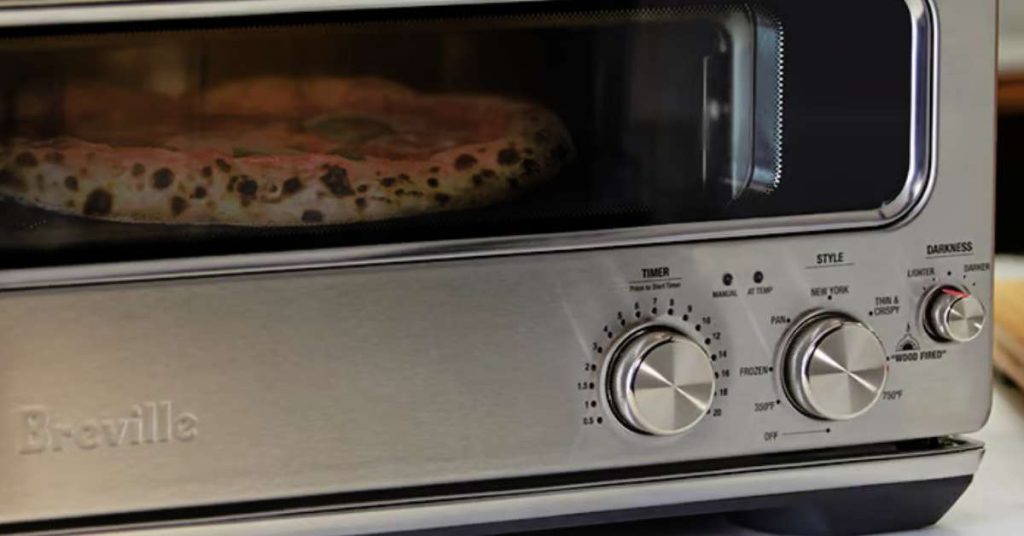
Top-Rated Indoor Pizza Ovens
The best indoor pizza oven for you comes down to price, performance, and features. For my money, the Ooni Volt 12 is easily the best indoor pizza oven on the market today, followed closely by the Breville Pizzaiolo Smart Oven and the European exclusive Effeuno P134H. Each of these three indoor pizza ovens are designed with quality and performance in mind and are priced at just under $1000.
If you’re on a tight budget, there are still some options as long as you’re willing to make some major sacrifices. The PYY indoor pizza oven sells for under $200, but it only reaches 600F and doesn’t have a stone or steel baking surface. If that’s not appealing, you can always just use a $100 pizza steel in your regular home oven and still get great results.
It’s also worth considering if you need an indoor pizza oven at all, since they’re considerably more expensive than some of the best outdoor pizza ovens. This is why I only recommend indoor pizza ovens for those who have a very good reason to own one, such as not having any outdoor space or even a balcony for an outdoor model.
Whatever your situation is, let’s dive into all the relevant details about indoor pizza ovens and figure out which one is best for you.
Related Post: Solo Pi Outdoor Pizza Oven Review
What is an Indoor Pizza Oven?
An indoor pizza oven is just like any other kind of pizza oven—it has a wide chamber that gets extremely hot with a stone baking surface designed to cook pizza. But indoor pizza ovens have one key distinction over traditional pizza ovens: they are safe for use indoors.
Typically, what makes a traditional pizza oven unsafe for indoor use comes down to the type of fuel it uses. When you burn traditional solid or liquid fuel, it creates gasses that are harmful or deadly when breathed in, and wood and charcoal also produce smoke. Definitely not ideal for indoor use.
To get around these issues without the need for complex ventilation systems, indoor pizza ovens leverage the use of electric powered heating elements that don’t produce any harmful gas or smoke and are safe to sit right on your kitchen counter.
Comparison Between Indoor vs Outdoor Pizza Ovens
When comparing indoor and outdoor pizza ovens, keep the following factors in mind. Outdoor pizza ovens are typically larger—often with up to a 16 inch baking surface. Outdoor ovens can also reach higher temperatures, which is useful when making wood-fired style pizza like Neapolitan.
However, outdoor ovens require more space and are dependent on good weather, which can limit when you’re able to use it. It’s also not a given that you need to be cooking at the maximum wood-fired temperatures of up to 1000F.
For one, Neapolitan style can cook just fine at around 800-900F, and many other popular styles actually do better under a lower heat, like New York and New Haven style.
Indoor pizza ovens also tend to be more compact because they’re designed to fit in a standard home kitchen. They may not reach the same extreme temperatures as outdoor ovens, but they can still produce excellent results with a crispy crust and even “leopard spotting” if it gets hot enough.
Above all, indoor pizza ovens give you the ability to cook pizzeria quality pizza right in your own kitchen. This is something that previously had to be done with a pizza steel in a regular oven which usually can only reach 500F.
Indoor Pizza Ovens Are More Versatile
One of the great things about indoor pizza ovens is their versatility. While an outdoor pizza oven can only be used outdoors, an indoor pizza oven can be used just as easily in your backyard as it can in your kitchen.
Depending on which model you choose, some electric indoor pizza ovens are weather resistant as well. This means you can make pizza indoors or outdoors even when there’s some drizzle or light snowfall. The Ooni Volt 12 is a great example of this.
That said, I don’t ever recommend using an electric pizza oven in a downpour—but for that matter, I wouldn’t use an outdoor pizza oven in the pouring rain either.
Benefits of Using an Indoor Pizza Oven
Convenience and Control
Indoor pizza ovens give you a certain amount of control over the cooking process that outdoor pizza ovens simply can’t offer. For example, the Ooni Volt 12 (which we’ll cover in more detail later) has various settings that allow you to carefully adjust the balance of heat from top to bottom based on your own preferences.
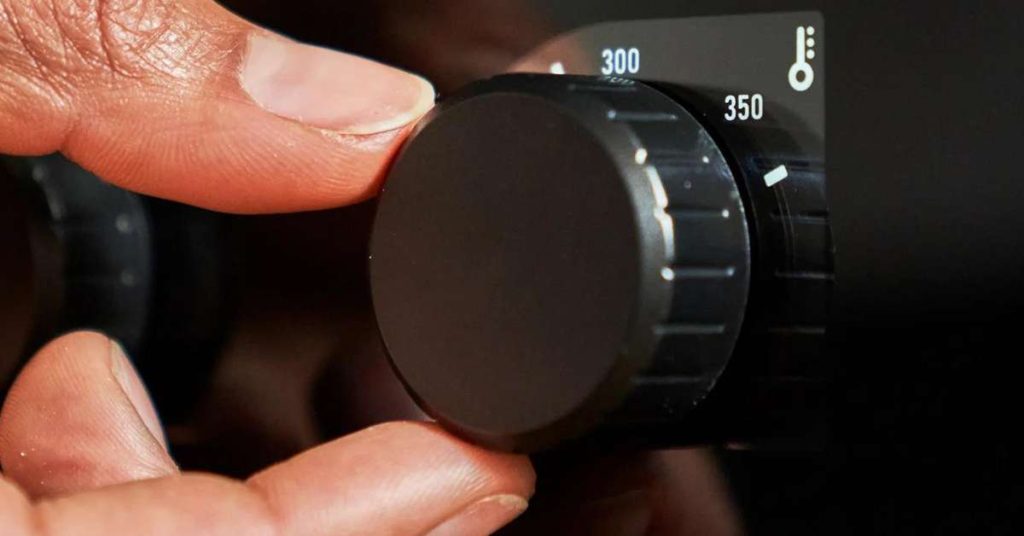
Some indoor pizza ovens also have a “boost” function that will temporarily boost the heat of the baking surface either for an extra well-done crust or simply to reheat it fast between pizzas.
This extra level of control comes from the fact that the heating elements are powered by electricity, which opens the door for digital control panels with custom heat and timing settings. These are things that simply aren’t possible when burning actual fuel—whether liquid or solid.
Hotter than a Regular Home Oven
Another major benefit of indoor pizza ovens is their ability to reach high temperatures. No, an electric oven won’t get as hot as a wood or propane fueled one, but compared to a regular home oven, they can get up to twice as hot.
A typical home oven will rarely get over 500F, and even then the actual temperatures you experience are often lower due to poor heat retention on older ovens. By contrast, an indoor pizza oven is designed to reach and maintain much higher temperatures that are ideal for making pizza.
Currently, the hottest indoor pizza oven on this list is the Ooni Volt 12 which can reach temperatures up to 850F. That’s not quite as hot as most outdoor models that can hit up to 1000F, but it’s a big step up from a home oven and more than hot enough for all styles of pizza.
But if you live in Europe, it’s a slightly different story since there are more indoor options available. For example, Europeans (and UK residents) can buy the Italian-made Effeuno P134H pizza oven which is technically capable of reaching up to 948F. Both this model and the Volt indoor pizza oven work amazingly well and are top of the line.
Versatility Beyond Pizza
While pizza is, of course, their specialty, indoor pizza ovens can cook more than just pizza. You can use them to cook lots of other dishes pretty easily, from roasted vegetables to baked breads and desserts. This makes them a great investment, as they can be used more often than just pizza night.
That said, anything besides pizza you can cook in an indoor pizza oven you can also cook in a regular home oven. And because you don’t have the rolling flame of a traditional outdoor pizza oven in an electric one, the benefits aren’t as obvious.
But if you want to cook something else in your indoor pizza oven besides pizza, that option is available to you. This is especially useful if whatever you’re trying to cook benefits from a higher heat than a home oven can provide.
How to Select the Best Indoor Pizza Oven (for you)
When picking out an indoor pizza oven, there are admittedly less options than with outdoor pizza ovens. You’ll also notice that indoor pizza ovens tend to be much more expensive than similarly featured traditional models.
This is mostly because of the safety and insulation considerations that have to be incorporated into the unit so that it’s fit for indoor use.
With all that in mind, try to keep the following factors in mind when making your decision:
Consider Your Space
When choosing an indoor pizza oven, one of the first things to consider is your space. You’ll need to make sure you have enough room in your kitchen for the oven, as well as enough ventilation for it to operate safely. Some ovens are more compact than others, so consider the size of the oven and the space you have available.
Thankfully, most of the indoor pizza oven models that are designed for domestic use (as in, not a pizzeria) are made to fit easily on a standard kitchen counter. This is the case for at least 3 of the models I’ve listed further down: the Ooni Volt 12, Breville Pizzaiolo, and the Effeuno P134H.
Ideal Temperature Range and Fuel Types
While most outdoor pizza ovens can reach (or at least claim to reach) up to 950F, indoor pizza ovens tend to vary more in their maximum temperatures. Pizzeria quality pizza is generally cooked at higher temperatures than a home oven can reach, so look for an oven that can reach at least 700°F.
But 700°F is really just a bare minimum, because ideally you want something that can approach the temperatures that outdoor pizza ovens can reach. This is generally in the 800-1000F range.
For example, the Breville Pizzaiolo can reach up to 750F, which is arguably not quite high enough for Neapolitan pizza, though it’s still certainly possible. On the other hand, the Ooni Volt 12 and Breville Pizzaiolo both easily hit the 850-950F range, which is the sweet spot for mimicking what’s possible in an authentic wood-fired pizza oven.
If your goal is to cook more American style pizzas, like New York and New Haven, you have more flexibility because these styles are generally cooked at a maximum of 700F, if not much lower.
Price and Features
Unfortunately, indoor pizza ovens aren’t cheap, especially as compared to the price of an outdoor pizza ovens of a similar size and with similar features
For example, the Ooni Volt 12, Breville Pizzaiolo, and Effeuno P134H each sell for close to $1000 when everything is factored in. This is relatively very expensive for a 12 inch pizza oven.
By comparison, the Ooni Fyra 12 is another 12 inch pizza oven, but because it’s designed for outdoor use only, the price is only $349.
Another example is the Ooni Karu 16, Ooni’s flagship pizza oven model with a 16 inch baking surface, multi-fuel support, and a slew of other bells and whistles. But because this is an outdoor pizza oven, the price is only $799.
So, when considering your budget for an indoor pizza oven, it really isn’t about comparing the prices of one indoor model to another because they’re generally all very expensive. Instead, you consider whether or not you need an indoor pizza oven at all, or if a cheaper outdoor model is a better fit.
Because of this major disparity in price between indoor and outdoor, I only recommend indoor pizza ovens to those who specifically want or need to cook indoors—either because of a personal preference, or a lack of outdoor space.
For example, if you live in an apartment without a balcony or yard, an indoor pizza oven is literally your only option. This might also be the case if you live in a region with extreme weather where it’s not possible to cook outside for most of the year.
Best Indoor Pizza Ovens Reviews
With the basics of indoor vs outdoor pizza ovens out of the way, let’s get right into the reviews.
You’ll notice that compared to other pizza oven roundups I’ve written over the years, this list of indoor pizza ovens is relatively sparse. That’s because there is genuinely a lack of quality indoor pizza ovens available compared to outdoor models, at least in North America.
That might surprise you because if you go to any department store, you’ll see dozens of electric “pizza ovens” for sale, but the truth is most of these models are glorified toaster ovens that don’t get any hotter than a regular home oven.
For this list, I’m only recommending pizza ovens that are capable of getting close to the heat of a traditional pizza oven, because otherwise you’re better off just buying a $100 pizza steel and using it in the oven you already own.
I’m also only listing models that I’ve personally had some experience with and are specifically designed with pizza aficionados in mind. I don’t want this to just be a list of whatever pops up on Amazon when you type in “indoor pizza oven” like you can find on so many trash AI generated pizza blogs out there.
| Specification | Ooni Volt 12 | Breville Pizzaiolo | Effeuno P134H | PYY Pizza Oven |
|---|---|---|---|---|
| Baking Surface Size | 13 x 13 inches | Barely 12 inches | 13.8 x 15.7 inches | 12.6 x 12.6 inches |
| Dimensions | 24.2 x 20.8 x 10.9 inches | 18.3 x 18.5 x 10.6 inches | 20.5 x 20.5 x 11.8 inches | 18.5 x 18.1 x 7.1 inches |
| Weight | 40 pounds | 46 pounds | 55.1 pounds | 39.7 pounds |
| Max Temperature | 850°F | 750°F | 950°F | 842°F |
| Fuel Type | Electric | Electric | Electric | Electric |
| Power | 1600 watts | 1800 watts | 2800 watts | 1100 watts |
| Volts | 120 | 120 | 230 | 120 |
| Price | $999 | $999 | $750 (approx) | $180 (approx) |
#1: Ooni Volt 12
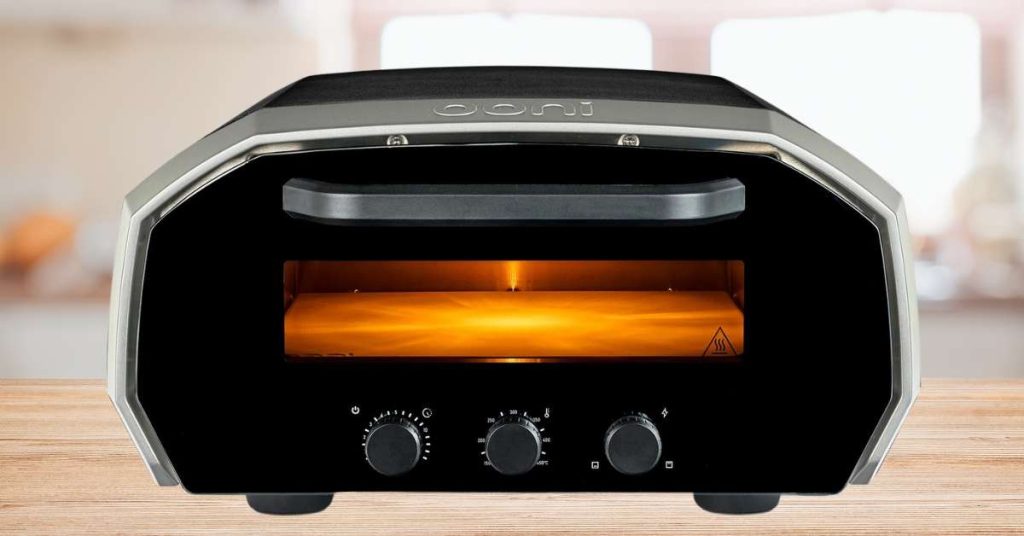
Overview and Unique Features
My top indoor pizza oven pick is the Ooni Volt 12 for several reasons. First and foremost, it’s the newest model on the market, released only in early 2023. This means the Volt has the benefit of hindsight and has addressed several of the main drawbacks of indoor pizza ovens available in the past—most notably, its ability to hit that 850F sweet spot for Neapolitan style pizza.
The Ooni Volt 12 is as impressive to look at as it is to use. When I first had the chance to interact with the Ooni Volt 12, I was immediately drawn to its heft for such a relatively small pizza oven—it feels heavier than it looks. This simply highlights how well the Ooni Volt 12 is at retaining heat, as well as the safety consideration taken when designing it.
In some ways, the Ooni Volt 12 reminds me of an indoor version of the Gozney Roccbox, another small but hefty pizza oven thanks to its super thick insulating layers.
Performance and Customer Reviews
In terms of performance, the Ooni Volt 12 delivers exactly as it’s been advertised. It can reach a maximum temperature of 850°F without any problems, which is higher than many other indoor pizza ovens on the market. This high heat allows the Ooni Volt to cook pizzas quickly and evenly, with the kind of leopard spotted crust you’ll typically only find using gas or wood-fired pizza ovens.
In terms of how the Volt has been received by the public, customer reviews for the Ooni Volt 12 are overwhelmingly positive. Like myself, users love its high heat, quick heat-up time, and the ability to use different built-in temperature settings and custom balance controls.
The main drawback of the Ooni Volt 12 is the price—$999 for a 12 inch pizza oven is expensive, and you’ll also need a peel in order to use it at all. That doesn’t mean it’s overpriced though, because indoor pizza ovens are designed differently and inherently more expensive than outdoor models.
Specifications, Pros, and Cons
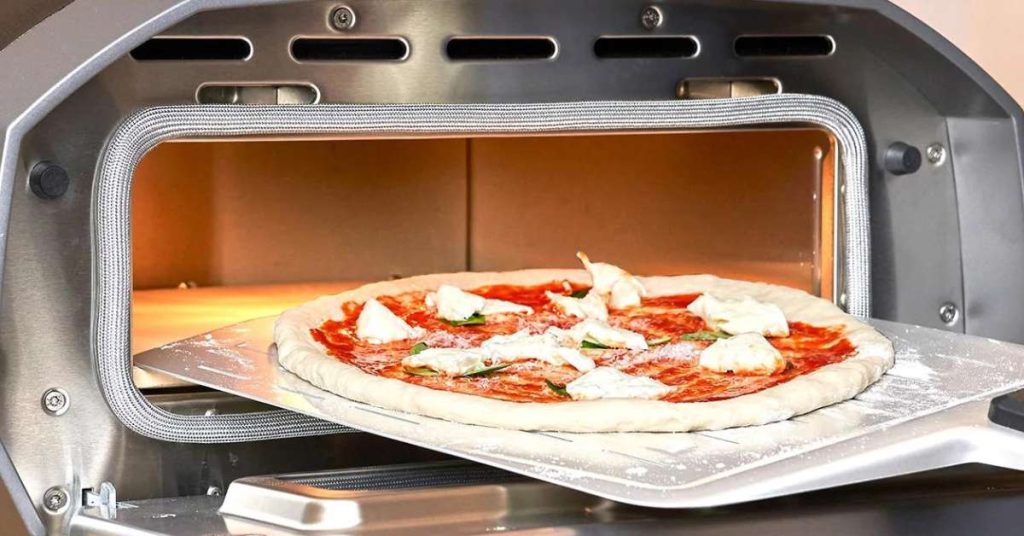
The Ooni Volt 12 has a baking surface size of 12 inches, making it big enough for a standard Neapolitan sized pizza—about the size of a large dinner plate. The oven is made from insulated stainless steel, which helps it retain heat and cook pizzas more efficiently.
One of the benefits of thick insulating layers is that it makes the oven safe for use around family and pets in your kitchen. If you’ve ever touched the side of a toaster oven when it’s in use, you’ll know what I’m talking about: it’s very easy to burn yourself.
By contrast, the Ooni Volt 12’s exterior is made from powder-coated stainless steel, which makes it (relatively) safe if you accidentally touch it while it’s fired up. This is a major benefit for anyone that has young ones or pets around the house when you’re making pizza. It also helps the oven retain heat and improves thermal efficiency.
The following are a list of pros and cons as I see them for the Ooni Volt 12:
Pros:
- Portable and easy to set up.
- Heats up quickly, reaching 850°F in 20 minutes.
- Safe, convenient electric heating.
- Tons of settings to play with for different pizza styles
- You can control the balance of heat on the top and bottom so the crust and toppings are cooked just right.
- Hefty, but not so heavy you can’t move it around easily. Also has carrying handles.
Cons:
- The small size isn’t great for bigger styles of pizza like New York and New Haven.
- Requires some playing around with the settings at first—your first pizza will likely be overdone or underdone to some extent.
- $999 is quite expensive for a 12 inch pizza oven
Specifications:
- Baking Surface Size: 13 x 13 inches
- Dimensions: 24.2 x 20.8 x 10.9 inches
- Weight: 40 pounds
- Max Temperature: 850°F
- Fuel Type: Electric
- Volts: 120
- Power: 1600 watts
#2: Breville Pizzaiolo
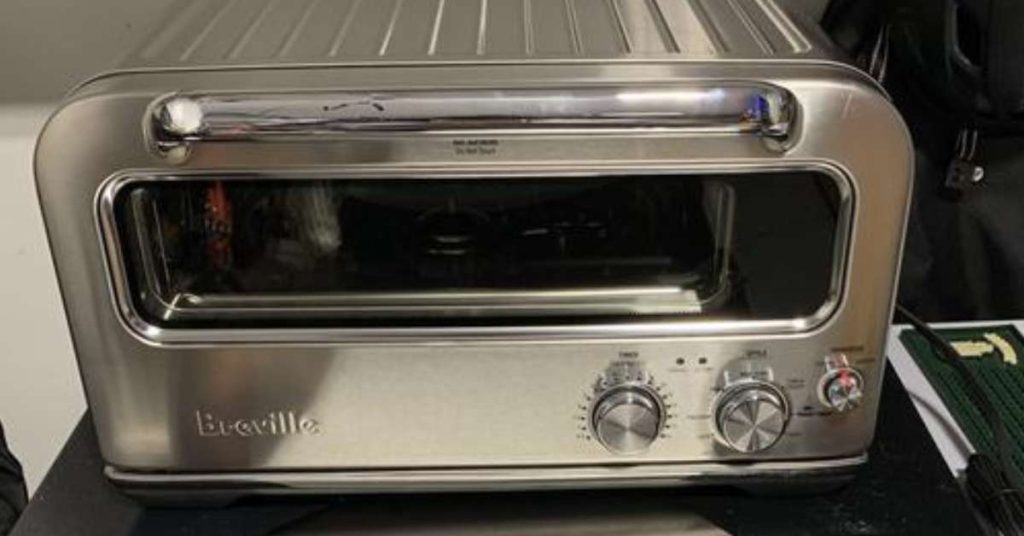
Overview and Unique Features
The Breville Pizzaiolo is one of the most well-known premium quality indoor pizza ovens on the market. This pizza oven has been available for years and for the longest time was the go-to indoor pizza oven for anyone serious about making pizza at home—at least in North America.
The Breville Pizzaiolo bills itself as a “smart” pizza oven, thanks to its “Element IQ” system. This system basically adjusts the temperature of each segment of its heating elements to ensure that the heat is consistent throughout the baking process. This is actually a nice feature because heating elements tend to have hot and cold zones.
Breville has also incorporated an innovative heat deflection “shield” at the top of the oven that attempts to replicate the dome of a traditional wood-fired oven. This is very useful in making sure that the top of the crust gets the leopard spotting and charring that makes pizzeria pizza so good.
These smart heating systems and mechanisms built-in to the Breville Pizzaiolo are probably why it’s able to perform so well despite only reaching 750F. I have to admit, I was pleasantly surprised to see charring on the crust at such a low temperature.
Like the Ooni Volt 12, the Breville Pizzaiolo is also very well insulated and relatively safe to the touch. I was initially skeptical about this, because based on the pictures it looks like a bare metal exterior, but after using it retains heat surprisingly well and doesn’t feel to hot.
Performance and Customer Reviews
Like I mentioned in the previous section, the Breville Pizzaiolo performs extremely well for a pizza oven that can only reach 750F. The engineering and thought put into this pizza oven is obvious, and the results speak for itself.
However, it’s worth noting that the Breville Pizzaiolo was updated in recent years and I’m not a huge fan of all the changes. For starters, the square cooking surface on the old Pizzaiolo oven has been replaced with a round one.
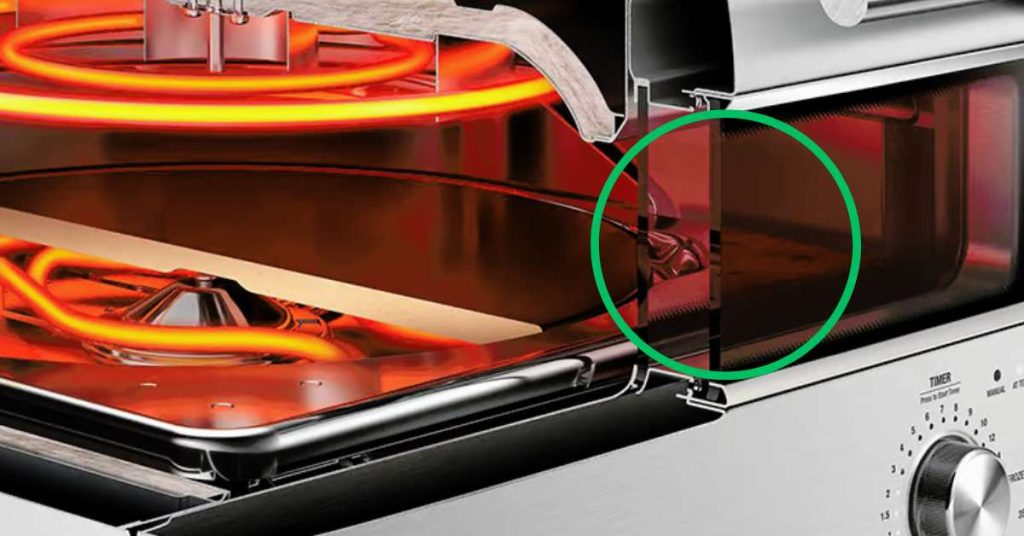
This might make sense at first, because most pizza is round, but I generally don’t like round baking surfaces because they’re smaller and require more precision to get the pizza exactly centered in the middle of it.
In terms of user reviews, they’re generally very positive. Users love its high performance, ease of use, and the quality of the pizzas it produces. For the most part, I agree—there isn’t a whole lot to complain about with the Breville Pizzaiolo besides its relatively lower heat and the round baking surface.
Specifications, Pros, and Cons
The Breville Pizzaiolo has a baking surface size of 12 inches and is priced at $999—exactly the same as its main competitor the Ooni Volt 12. Like the Volt, the Pizzaiolo oven is made from stainless steel and features a built-in cordierite pizza stone and various settings to play around with.
In terms of cons, I’ll refer again to the round baking stone. I don’t know why they changed this from the previous model (I’m sure they have a reason), but I really have trouble getting behind a round baking surface. In fact, it’s one of the main reasons why I don’t hesitate to rank the Ooni Volt 12 much higher despite similar specs and pricing.
That said, this newer version of the Breville Pizzaiolo is more efficient and “smarter” than the previous version. I’m not really sure if Breville changed the baking surface as a workaround to another problem, to lower costs, or as a “feature” because most people think a round baking stone makes sense for cooking a round pizza.
I’ll say this, though—most people don’t seem to mind the round baking stone. In fact, I’ve seen very little (if any) complaints about it online. Maybe it’s just because I have a lot of experience using pizza ovens and just have certain expectations, or maybe these users online simply don’t have anything to compare it to.
For me, a round baking surface is just wasted space, and if you happen to miss when launching your pizza into the oven, whatever corners spill over the circle won’t cook as well as the rest of the crust. This is an oversight, in my opinion.
Besides that, the Breville Pizzaiolo looks great and works great, so if you don’t mind the round baking stone, you’ll probably love this pizza oven.
Pros:
- Offers a variety of cooking modes for different pizza styles.
- Heats up to 750°F in just 20 minutes.
- The built-in heat control system helps prevent burning and cooks the crust very evenly.
- Very good thermal design for heat convection despite small size.
- Outperforms for a pizza oven that only reaches 750F.
Cons:
- $999 is quite expensive for a 12 inch pizza oven that only reaches 750F.
- The recent switch to a smaller round baking surface really grinds my gears (why??).
- Relatively heavy compared to the Ooni Volt 12
- Same price as Ooni Volt 12 which gets hotter.
Specifications:
- Dimensions: 18.3 x 18.5 x 10.6 inches
- Baking surface: Barely 12 inches
- Weight: 46 pounds
- Max Temperature: 750°F
- Fuel Type: Electric
- 120 volts
- Power: 1800 watts
#3: Effeuno P134H
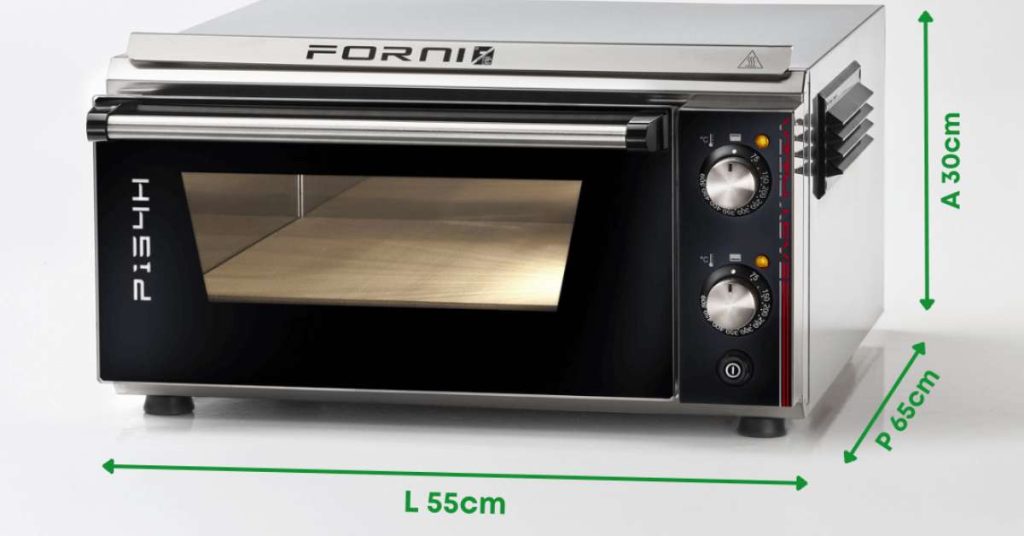
Introduction and Unique Features
The Effeuno P134H is a beast of an indoor pizza oven, and if you’re familiar at all with the European pizza making scene, you’ve probably seen one or heard about them. This oven is known for its crazy build quality and exceptional performance. It features a super thick refractory stone baking surface and a powerful heating element that reach up to 950F.
Performance and Customer Reviews
The Effeuno P134H is a powerhouse when it comes to performance, reaching temperatures of up to 950F, which is pretty incredible for an indoor pizza oven. It also features one of the thickest and most robust baking stones I’ve ever seen in a domestic pizza oven.
I first had the chance to use this pizza oven while visiting family in Europe. In fact, as far as I know, it’s really only available within the EU and UK unless you’re willing to pay heavy duties and shipping fees. If you can find one at a local shop anywhere in North America, let me know!
Amazingly, the base price for the Effeuno P134H is only 669€ (around $750 USD) which actually makes it less expensive than both the Ooni Volt 12 and the Breville Pizzaiolo. This is very impressive considering that it’s easily the most powerful and feature-packed indoor pizza oven on this list. It also includes a pizza peel for the price.
So, if you live in Europe, I recommend checking out the Effeuno P134H, otherwise your best bet is either the Ooni Volt 12 or the Breville Pizzaiolo.
Specifications, Pros, and Cons
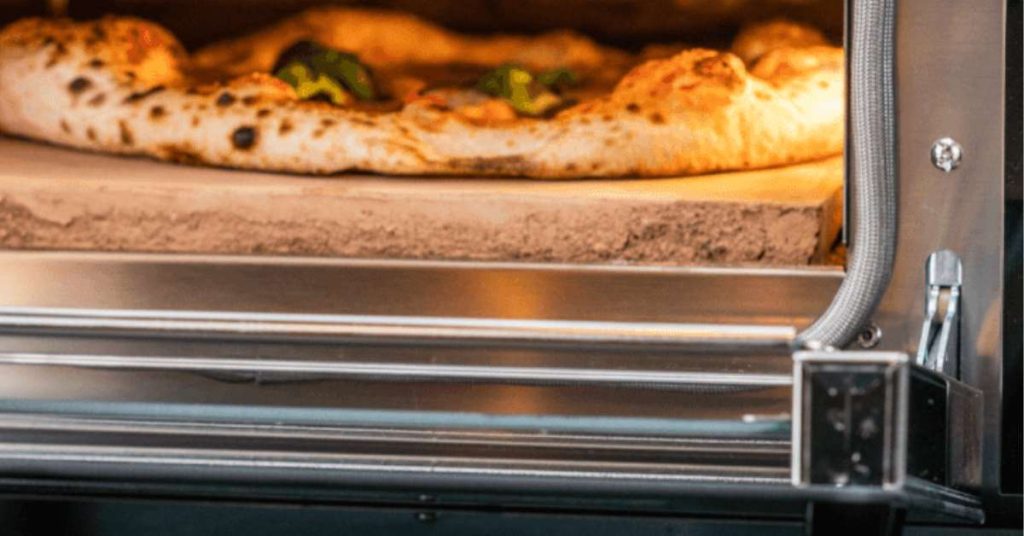
The Effeuno P134H has a relatively large baking surface at 13.8 x 15.7—much bigger than any of the other options on this list. It’s made from stainless steel and has a baking stone at least twice as thick as what you usually find in portable pizza ovens, even outdoor ones.
The Effeuno P134H also offers an extremely high maximum temperature of 950F (509C), quick preheat time, and a premium-grade construction. This Effeuno P1345H almost feels like a miniature commercial pizza oven designed for a regular kitchen. Leave it to the Italians to come up with a pizza oven like this.
There really are no downsides to the P134H, especially if you live in Europe. I just wish this pizza oven was more readily available outside of the EU, and Italy in particular.
Pros:
- Blisteringly high 950F max temperature, ideal for Neapolitan pizza.
- Has an extra large cooking surface.
- Has an extra thick baking stone
- Various heat settings for fine tuned temperature control.
Cons:
- It’s quite heavy and not that portable—over 55lbs.
- Not easy to find outside of Europe.
Specifications:
- Baking Surface Size: 13.8 x 15.7 inches
- Dimensions: 20.5 x 20.5 x 11.8 inches
- Weight: 55.1 pounds
- Max Temperature: 950°F (509°C)
- Fuel Type: Electric
- Power: 2800 watts
- Volts: 230
Budget Option: PYY Pizza Oven
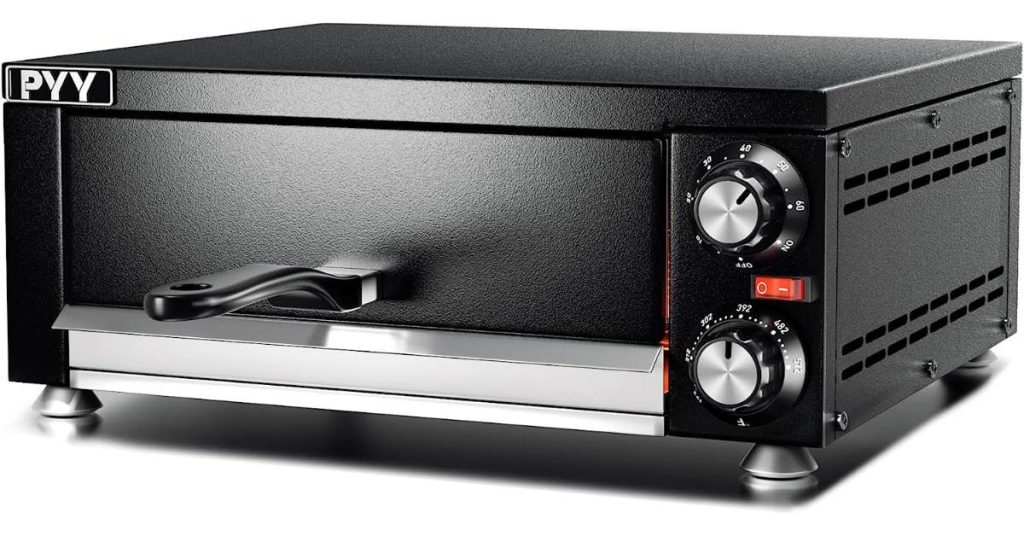
Introduction and Unique Features
So, the PYY isn’t like the other pizza ovens on this list. It’s basically an Amazon exclusive pizza oven made by a no-name manufacturer (PYY). Technically, It’s not even really a pizza oven, although it’s marketed as one.
The PYY indoor pizza oven is essentially a smaller version of some of the larger commercial electric pizza ovens you might find in fast-food pizzerias, like a Domino’s or a Pizza Hut. It doesn’t even have a baking stone, just a removable tray, which makes it more suited for pan pizza than traditional crust.
That said, there’s nothing stopping you from adding a pizza stone on top of the tray if you can find one that fits it. But don’t expect any Neapolitan leopard spots because the PYY only reaches temperatures just slightly below 600F.
The only reason I’m including this pizza oven on the list is because it’s readily available on Amazon and costs less than $200—significantly less expensive than any of the other indoor pizza ovens here. And for some people out there, it might be just what they’re looking for.
Performance and Customer Reviews
The PYY pizza oven isn’t very powerful, and it also isn’t very big either. The inner chamber of the oven is just big enough for a 12 inch pizza, but even that is probably a stretch. And like I mentioned, there really isn’t much of a “baking surface” to speak of, just a tray that slots in and out.
But honestly, what do you really expect from an indoor electric “pizza oven” that only costs around $180 (or less when frequently on sale)? It also reaches temperatures of around 570F, which is higher than a regular home oven.
I also find it kind of funny that all of the Amazon video reviews for this oven show it cooking frozen pizza. It’s one thing to use the PYY for some budget-friendly experimentation, but why would you need a $200 oven to cook frozen pizza crust that’s already pre-cooked? But hey, what do I know?
That said, I’m torn on the PYY pizza oven because I’m not convinced that it’s better than simply using a pizza steel in a regular oven. For some people, the convenience of having a compact unit on your counter will be worth it, especially if (maybe) you don’t have a regular oven to work with. But others will be better off with a pizza steel in a home oven—cheaper, more convenient, and with the potential for larger pizzas.
At less than $200, though, it’s worth considering, which is why I’ve included it here. That’s over 5x less expensive than the other indoor pizza ovens on this list.
Specifications, Pros, and Cons
Let’s be honest—the PYY pizza oven is barely more than a toaster oven with a conveniently flat form factor for making pizza. And to make any kind of pizza without a pan, you’ll need to insert some kind of a baking stone or steel.
That said, with what little experience I have with this “pizza oven”, it’s a reliable little unit that hits the temperatures it advertises. And if you add a baking stone or steel in there, you should be able to hit surface temperatures of well over 600F—not bad for such an inexpensive oven.
I’m giving the PYY a lot of leeway here because it’s so inexpensive and readily available over Amazon. If you’re looking for anything remotely authentic, for sure stay away from the PYY. But for others on a budget and willing to experiment with something different, the PYY pizza oven is an enticing option to consider.
Pros:
- Well insulated, good build quality.
- Hits temperatures slightly above a regular home oven (570F+)
- Easy to clean since the baking surface is completely removable.
- Incredibly inexpensive (less than $200)
- Good for Domino’s or Pizza Hut style pizza
- Great for frozen pizza (but so is any oven)
Cons:
- Cramped baking area.
- Heat isn’t fine tuned for pizza making.
- No baking surface—you’ll need to add your own stone or steel, if it fits.
- Only reaches temperatures barely higher than a regular oven (570F).
- Debatably not as good as a regular home oven with a pizza steel.
- Glorified toaster oven—but a decent one.
Specifications:
- Dimensions: 18.5 x 18.1 x 7.1 inches
- Baking Surface Size: Around 12 inches
- Weight: 20 pounds
- Max Temperature: 570°F
- Fuel Type: Electric
- 120 volts
- Power: 1100 watts
Best Practices When Using an Indoor Pizza Oven
Getting Started
When using an indoor pizza oven, it’s important to start by reading the manufacturer’s instructions. Each oven is different, and understanding how your specific model works will help you achieve the best results. This is especially true with electric models which typically have more settings and options than traditional pizza ovens.
Make sure you know how to control the temperature, how long it takes to preheat, and any other specific features your oven may have. Beyond that, indoor pizza ovens are pretty simple to use—you basically just turn them on and heat them up until it’s ready.
Cooking Your Pizza
When it comes to cooking your pizza, an indoor pizza oven works pretty much the same as an outdoor pizza oven. First, make sure your oven is fully preheated before you put your pizza in. This will ensure an even cook with good browning.
Second, keep an eye on your pizza as it cooks. Indoor pizza ovens can cook pizzas very quickly since the heating elements are so close, and it’s easy to burn your pizza if you’re not careful. Finally, rotate your pizza halfway through the cooking process to ensure an even cook, just like with any pizza oven.
Cleaning and Maintenance
After you’ve made your pizza, it’s important to clean the oven. This will help to ensure the oven stays in good working order for years to come, as well as keep your pizza from getting a bitter taste from absorbing any burned debris from your last cook.
Thankfully, this is pretty easy to do with an electric pizza oven because there is no ash or soot to contend with. Generally, you can just wipe out any organic matter or debris with a brush. If anything gets stuck to the baking surface, just use the back of a metal spatula to gently scrape it away.
Comparison and Recommendations
With several great options to choose from, picking the right indoor pizza oven means weighing features and price with your budget and lifestyle.
If you’re craving authentic, wood-fired pizza with a leopard spotted Neapolitan crust, the Ooni Volt 12 comes as close as you can get with electric heating—at least in North America. Despite the premium price of $999, purists will appreciate its thermal efficiency, max temperature of 850F, and fine-tuned heat controls.
If you live in Europe, the choice is pretty clear—the Effeuno P134H packs a 950°F punch at lower cost than the Ooni Volt and Breville Pizzaiolo. Unfortunately, if you live outside of Europe, this oven either isn’t available or is prohibitively expensive when duties and shipping fees are included.
The Breville Pizzaiolo Smart Pizza Oven has been on the scene for a while, and might just be the most well known premium-quality indoor pizza oven on the market. It only hits temperatures of 750F, but its unique thermal design makes for a surprisingly good crust despite what the low numbers would otherwise suggest. But at $999, it’s the same price as the slightly better and newer Ooni Volt 12. I also don’t love the round baking surface design choice in the latest revision.
Finally, the super cheap PYY pizza oven isn’t great and doesn’t perform that well, but at less than $200 it’s worth considering. Yes, you’ll be making lots of compromises such as the lack of a baking stone, and no, it’s not authentic, but it does work well for what it is. Adding in your own baking stone or pizza steel can really improve things, but it might not be as good as a steel and regular home oven. It really depends on you and what you’re looking for. I can see this being a fun toy to tinker with if you like experimenting.
Final Thoughts
Ultimately, align your priorities and budget to narrow the selection. If top-tier pizza matters most, go for the Volt 12 or P134H. The Breville Pizzaiolo has its flaws, but still makes excellent pizza without many compromises. And if you absolutely can’t afford any of those other options, the PYY is a great choice, especially if you don’t already have a regular home oven for whatever reason.
Key Takeaways:
- Indoor pizza ovens use electric heating for safety.
- Outdoor ovens are typically larger, reach higher temps, but can only be used outdoors.
- Indoor ovens are generally more compact for countertop use in home kitchens.
- Higher-end indoor pizza ovens reach 700-950°F, much hotter than a typical home oven.
- Ooni Volt 12 hits 850°F, the hottest indoor oven available in North America.
- Effeuno P134H reaches 950°F but mainly available in Europe.
- Electric heating allows for precise digital temperature controls.
- Many indoor pizza ovens can be used outdoors too, unlike outdoor-only models.
- My top picks are the Ooni Volt 12, Breville Pizzaiolo, Effeuno P134H, and budget-friendly PYY Pizza Oven.
- Consider size, max temp, extra features, and price when selecting an indoor oven.
- Indoor ovens cost a lot more than comparable outdoor ovens.
- Benefits of indoor pizzaz ovens include convenience, control, and hotter than home ovens.
Ooni Volt 12 Indoor Pizza Oven
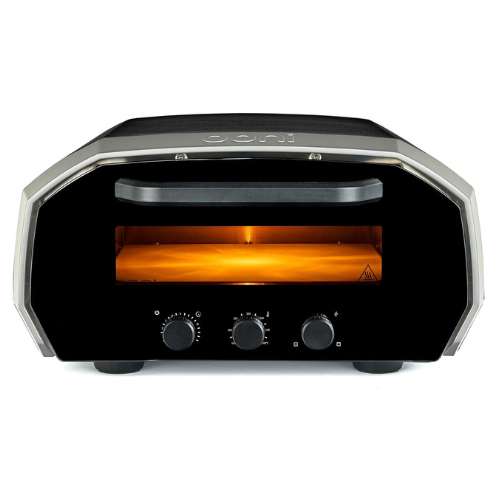
Summary
The Ooni Volt 12 is the newest addition to the indoor pizza oven market. Unlike most of its competitors, the Volt can reach temperatures up to 850F, making it perfect even for Neapolitan style pizza. It’s not overpriced, but still expensive, so make sure you actually need an indoor oven because outdoor models are much cheaper.
Related Questions
Is it worth getting an indoor pizza oven?
Indoor pizza ovens are expensive compared to outdoor pizza ovens, so you should only consider one if you have a really good reason to want to use one specifically inside. A great use case scenario for an indoor pizza oven is if you don’t have a yard or a balcony for an outdoor model.
What pizza ovens can you use indoors?
Generally speaking, the only pizza ovens you should ever use indoors are electric. This is because non-electric pizza ovens burn wood, charcoal, or gas, each of which produces harmful CO2 and smoke when combusted. Electric pizza ovens don’t produce any harmful byproducts so are completely safe to use indoors.

